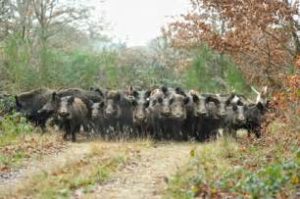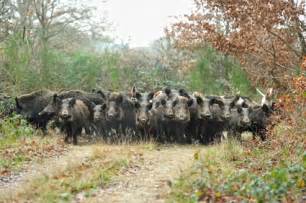 Today, 15h August, the Chasse au Sangliers begins. For the next six months every Wednesday, Saturday and Sunday the Hautes Corbieres will resonate to the barking of dogs hot on the trail of sangliers, wild pigs, and the sounds of shots.
Today, 15h August, the Chasse au Sangliers begins. For the next six months every Wednesday, Saturday and Sunday the Hautes Corbieres will resonate to the barking of dogs hot on the trail of sangliers, wild pigs, and the sounds of shots.
The early morning roads will be full of the dodgiest 4x4s in France, and the Mercedes of urban warriors heading for the hills to sate their blood lust. Lines of camouflaged men, and a few women, will string out over the hills- they are surprisingly visible as over their camouflage they are now obligated to wear bright orange day glow gillets and base ball hats. They remind me of that Robin William’s fashion tip in Good Morning Vietnam, ”If you are going to go into the jungle- clash”.
The Prefectoral order this year is staggering, the hunt has been requested to kill 20;000 pigs in the Aude this season. Particularly high numbers of kills have been allocated to the Hautes Corbieres and the Haut vallee d’Aude.
This is no surprise, the number of pigs in these two areas have been rising steadily for a decade. The damage they do to the countryside can been seen along any roadside, even in our garden. The long dry period we have had this year has dried up their source of acorns, their principal diet along with roots, grubs and worms, as it has the standing water and streams of the Hautes Corbieres. This has forced the pigs to search for food and water lower and lower into the valleys, closer to the vines and villages. The hunt, who has an obligation to monitor the number of beasts in their area, now freely admit they have lost count and can only give a loose estimation.
Three factors have played a role to create the present situation.
Firstly the pigs themselves are now giving birth to much larger litters of marcassins, piglets. A pure blood sanglier will give birth to a litter of no more than two piglets o,ce a year, but if the mother has mixed blood, part wild boar par domestic pig, then the number can rise to six to eight; twice a year. They have problems keeping that number alive, but it is still causing the population to increase. It is very difficult to keep horny male boars off domestic pigs, a friend of mine has her domestic black pigs enclosed in a wire fenced enclosure, with electric wires at snout height to keep the wild romeos out. She still found clear signs that they had been covered by wild sangliers, the tell tale signs of deep cuts on the females backs, where they had been gorged by the tusks of male sangliers shocked her. The resulting mixed race piglets were a clear sign that despite her best efforts the male sangliers had overcome her defenses. There are also unconfirmed rumours that deliberate cross breeding has been done in the past by the hunters themselves to increase their potential targets.
The second factor is the decline of the agricultural sector in both the Hautes Corbieres and the high Aide valley. With the decline of the area of land farmed, and the linked growth of the Garrigue the land available to sangliers have increased, and the population expands into the space available. This decline also increases the cost for already struggling paysans, small farmers, who dominate what is left of the agricultural sector in these areas. Agricultural insurance companies now insist that land is enclosed with both wire fences and electrical fences, if not then the crops are not covered against wild animal damage. This is a huge cost for Corbieres farmers that is not shared by their colleagues down on the plains. Sanglier pose two risks for vine growers, the boar eat the leaves of the vines if there is little greenery in the wild, as happens during long dry spells like this one, and also when the grapes ripen and the sugar level reaches a certain level, the pigs love to strip them off the vine. It is the sangliers equivalent of a primary school being let lose in a chocolate factory. They are also the reason very few farmers grow maize or chick peas in the Hautes Corbieres, short of having armed guards on patrol every night, sangliers are mainly nocturnal, there is no way to protect the crop. The 16th and 19th century saw the eradication of top line predictors, bears and wolves, and the 20th century the decimation of the agricultural sector. A perfect storm for expansion of the sanglier population.
The third factor is the hunt itself. The aging population of the Hautes Corbeires, the lack of a younger generation to take over the work means that the nature of the hunter have changed. The hunt traditionally has been a local working class/agricultural activity. It was a major source of protein for rural communities and was practiced by men that knew intimately the land they were hunting and the habits of the beasts they were killing. Much of this knowledge has now gone. Yes the locals still hunt, but they are joined by lawyers from Toulouse, plumbers from Lezignan, and bankers from London and Paris. These weekend warriors may not lack in enthusiasm, but they do not bring the skill or deep understanding of the land that locals hold. It also changes the priority of the hunt, a particularly troublesome sanglier that has been destroying local crops can be passed over in order to up the kills so that high paying visitors can take their picture next to a corpse. Every year we use to hold a Sunday lunchtime appero and grill for our local hunt; as a thank you for their work, and because if you are going to have heavily armed men tramping over your land it is better that they know you and like you. This tradition has now ended as the head of hunt appologised, the weekend warriors wanted to spend every minute on the hill and not sipping pastis chez nous. It is a shame, but you cannot march backwards into the future. The weekend hunters provide a good revenue for the hunt, and fill empty hotels and gites.
That is not to say that the hunt does not try to keep its responsibilities. The hunt is charged with protecting crops, and a good hunt will go out of it’s way to do so. Increasingly this is done on Wednesday’s when the hunt is manly comprised of locals rather than visitors. Today, on the first day of the hunt and for the next few weeks they will be shooting down by the vines to try and limit the pig damage to crops. The Prefect lifted the June ban on hunting, when the piglets are to small to be separated from their mothers, in the maize, and chick pea growing areas because of the extensive damage the pigs had caused to crops.
We need the hunt, not least because the alternative is worse- poison or trapping, or both. Both can be effective at controlling wildlife, the problem is that they are non discriminatory, they kill or trap anything and everything.
Of course the best solution would be a revival of the agricultural sector, a renewal of village life providing a new pool of local hunters. A man can but dream.

